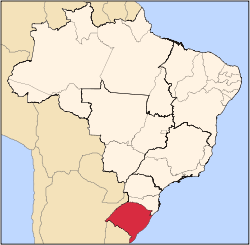Santiago, Rio Grande do Sul
| Santiago | |
|---|---|
| Municipality | |
 Map of the state of Rio Grande do Sul, Brazil highlighting Santiago | |
| Coordinates: 29°11′30″S 54°52′2″W / 29.19167°S 54.86722°WCoordinates: 29°11′30″S 54°52′2″W / 29.19167°S 54.86722°W | |
| Country | Brazil |
| Region | South |
| State | Rio Grande do Sul |
| Micro-region | Santiago (capital) |
| Founded | January 4, 1984 |
| Area | |
| • Total | 3,264.3 km2 (1,260.4 sq mi) |
| Elevation | 409 m (1,342 ft) |
| Population (2003) | |
| • Total | 51,375 |
| • Density | 16/km2 (41/sq mi) |
| Demonym | Santiaguense |
| Time zone | UTC-3 (UTC-3) |
| • Summer (DST) | UTC-2 (UTC-2) |
| Postal code | 409x |
| Area/distance code | (00)55-Brazilian area code |
| IBGE code | 4322376 |
| Distance to capital | 450 km (280 mi) |
| Website | santiago.rs.gov.br |
Santiago (Portuguese meaning Saint James) is a municipality of the western part of the state of Rio Grande do Sul, Brazil. It serves the capital of the microregion of the same name. Its area is 3,264.3 km² and its population was 51,375 in 2003. Its elevation is at 361 m. It is located 450 km west of the state capital of Porto Alegre and northeast of Alegrete. Its nickname of the city is "The Land of the Poets".
Santiago Airport serves the city.
Neighboring municipalities
- Bossoroca
- Capão do Cipó
- Tupanciretã
- Jari
- Jaguari
- Nova Esperança do Sul
- São Francisco de Assis
- Unistalda
- Itacurubi
History
In about 1860, it began the settlement of the region. The colony was first founded by 350 Germans, 14 Belgians, 5 French persons and 4 Swiss persons. Colonel José Maria Pereira de Campos created and organized the colony of Ijuí and brought Europeans to the area. The Italians arrived in the 1880s, as the century passed, with the establishment of the colony of Jaguari, the localities of Sanga da Areia and Ernesto Alves. In 1834, Arsene Isabelle, a French diplomat, in ways between the area, refers to a locality of Boqueirão de Santiago, its existence of three to four ranches. The Germans and the Italians form a large influx of European immigration, a mixture with other nationalities which saw Belgians, Swiss, Polish and French immigration. In synthesis, the colonies were established in 1860 and had diverse types of humans in the municipality of Santiago, with no other municipalities, the population became predominantly European descent.
Education
Santiago has a campus of the Universidade Regional Integrada do Alto Uruguai e das Missões
Communications
Radio
- Rádio Nova 99 FM Website, Live broadcast
- Verdes Pampas FM Website, Live broadcast
- Rádio Santiago AM Website
Personalities
- Luiz Carlos Prates: Radio-journalist and psychologist
External links
- Officual Website
- Universidade Regional Integrada - Campus Santiago-RS
- Santiago-RS
- Santiago Flogger e Região
- http://www.citybrazil.com.br/rs/santiago/ (Portuguese)
